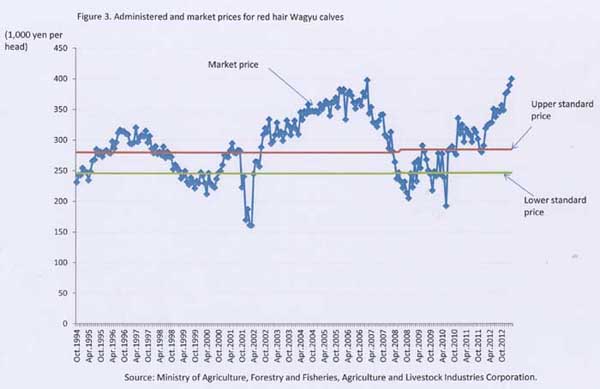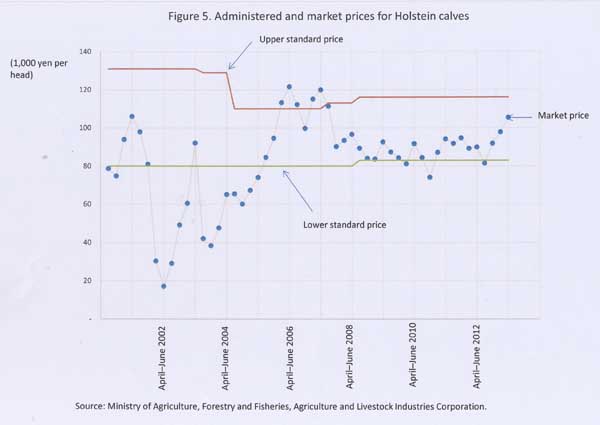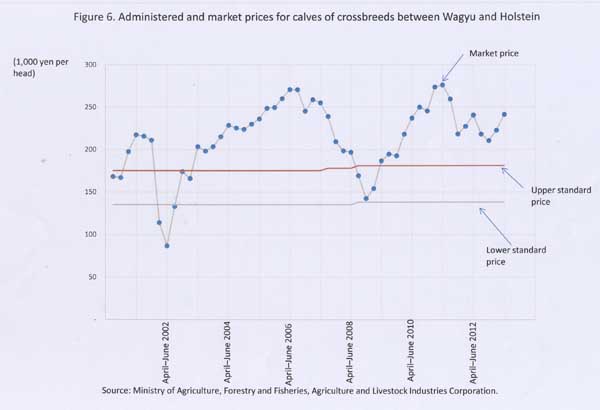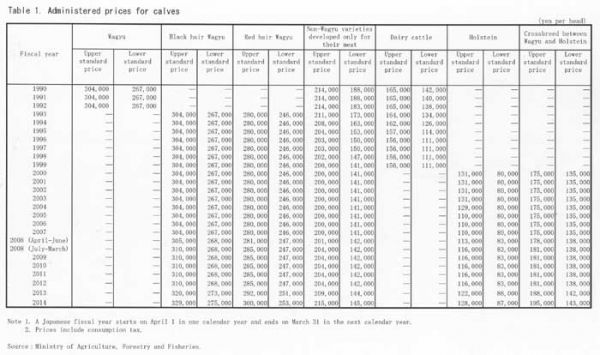Yoshihisa Godo,
Professor, Meiji Gakuin University, Japan
There are nearly 60,000 breeders of beef cattle in Japan1. They play an essential role in the meat industry and create important job opportunities in rural areas. Most cattle breeders are small-sized family farmers and, therefore, are vulnerable to financial shocks. Thus, the Japanese government has provided various means of support to them.
Previously, the Japanese government used import quotas to control the total amount of beef imports. However, in 1988, under fierce pressure from foreign governments, the Japanese government decided to abolish import quotas on beef within three years. This decision made domestic beef farmers anxious about whether they would survive with freer competition from their foreign counterparts. To mitigate the shock of the abolishment of beef import quotas, the Ministry of Agriculture, Forestry and Fisheries (MAFF) introduced a unique subsidy system for breeders of beef cattle. Specifically, the MAFF produced the Special Act for Stabilization of Beef Calf Production (SASBCP) in 1988 and started the Program for Stabilization of Beef Calf Production (PSBCP) in 1991 based on the SASBCP.
The PSBCP system is shown in Figure 1. It guarantees minimum revenue to breeders of beef cattle by providing subsidies through the Agriculture and Livestock Industries Corporation (ALIC), an extra-governmental body of the MAFF2. The SASBCP classifies cattle into five types: black hair Wagyu (Wagyu is a variety of cattle developed in Japan only for its meat), red hair Wagyu, non-Wagyu varieties developed only for their meat (“others” hereafter), Holstein (a variety of dairy cattle), and crossbreeds of Wagyu and Holstein (“F1” hereafter). Until March 1993, black hair Wagyu and red hair Wagyu were categorized as the same type of Wagyu; until March 2000, Holstein and F1 were categorized as the same type of dairy cattle.

The MAFF sets two administered prices for each type of calf: an upper standard price and a lower standard price. An upper standard price is the breakeven price for an average breeder. A lower standard price is the price at which breeders have to make efforts to lower the production cost of a calf.
The SASBCP requires prefectural governors to set up designated local bodies for the PSBCP. The designated local bodies build up funds for the PSBCP by collecting money from the ALIC (50% of the total funds), prefectural governments (25%), and breeders (25%). The ALIC monitors the market calf price of each type of cattle3. If the market price is lower than the upper standard price and higher than the lower standard price, the ALIC compensates for the gap between the upper standard price and the market price. If the market price is lower than the lower standard price, the ALIC compensates for the gap between the upper and lower prices and the designated local bodies compensate for 90% of the gap between the market price and the lower standard price by disbursing their funds.
Table 1 shows the changes of administered prices. They are usually fixed during the same fiscal year (the Japanese fiscal year starts on April 1 in one calendar year and ends on March 31 in the next calendar year). The 2008 fiscal year is an exception because the prices of feeding crops shot up unexpectedly, causing the MAFF to revise the administered price in July 2008.
Comparisons between the market and administer prices for five types of calf are shown in Figures 2–6. As can be seen, calf prices for all types plunged in 2001. This is because demand for beef decreased drastically immediately after the outbreak of Bovine Spongiform Encephalopathy in September 2001.
Breeders of black hair and red hair Wagyu and F1 receive PSBCP subsidies for limited times only. Recipients of PSBCP subsidies are mainly breeders of Holstein and other types. In particular, breeders of Holstein receive subsidies almost annually. This reflects the fact that Holstein beef is the lowest quality beef produced in Japan and faces fierce competition with inexpensive imported beef.






Footnotes
1 Godo, Yoshihisa. “Beef market and beef cattle farmers in Japan,” FFTC Agricultural Policy database, 2014. http://ap.fftc.agnet.org/ap_db.php?id=279.
2 The ALIC was called the Livestock Industry Promotion Corporation until 1996.
3 The market price is calculated as the three-month average of trading prices of calves that satisfy the standard conditions designated by the MAFF.
|
Date submitted: Aug. 21, 2014
Reviewed, edited and uploaded: Aug. 21, 2014
|


A Subsidy Program for Breeders of Beef Calves in Japan
Yoshihisa Godo,
Professor, Meiji Gakuin University, Japan
There are nearly 60,000 breeders of beef cattle in Japan1. They play an essential role in the meat industry and create important job opportunities in rural areas. Most cattle breeders are small-sized family farmers and, therefore, are vulnerable to financial shocks. Thus, the Japanese government has provided various means of support to them.
Previously, the Japanese government used import quotas to control the total amount of beef imports. However, in 1988, under fierce pressure from foreign governments, the Japanese government decided to abolish import quotas on beef within three years. This decision made domestic beef farmers anxious about whether they would survive with freer competition from their foreign counterparts. To mitigate the shock of the abolishment of beef import quotas, the Ministry of Agriculture, Forestry and Fisheries (MAFF) introduced a unique subsidy system for breeders of beef cattle. Specifically, the MAFF produced the Special Act for Stabilization of Beef Calf Production (SASBCP) in 1988 and started the Program for Stabilization of Beef Calf Production (PSBCP) in 1991 based on the SASBCP.
The PSBCP system is shown in Figure 1. It guarantees minimum revenue to breeders of beef cattle by providing subsidies through the Agriculture and Livestock Industries Corporation (ALIC), an extra-governmental body of the MAFF2. The SASBCP classifies cattle into five types: black hair Wagyu (Wagyu is a variety of cattle developed in Japan only for its meat), red hair Wagyu, non-Wagyu varieties developed only for their meat (“others” hereafter), Holstein (a variety of dairy cattle), and crossbreeds of Wagyu and Holstein (“F1” hereafter). Until March 1993, black hair Wagyu and red hair Wagyu were categorized as the same type of Wagyu; until March 2000, Holstein and F1 were categorized as the same type of dairy cattle.
The MAFF sets two administered prices for each type of calf: an upper standard price and a lower standard price. An upper standard price is the breakeven price for an average breeder. A lower standard price is the price at which breeders have to make efforts to lower the production cost of a calf.
The SASBCP requires prefectural governors to set up designated local bodies for the PSBCP. The designated local bodies build up funds for the PSBCP by collecting money from the ALIC (50% of the total funds), prefectural governments (25%), and breeders (25%). The ALIC monitors the market calf price of each type of cattle3. If the market price is lower than the upper standard price and higher than the lower standard price, the ALIC compensates for the gap between the upper standard price and the market price. If the market price is lower than the lower standard price, the ALIC compensates for the gap between the upper and lower prices and the designated local bodies compensate for 90% of the gap between the market price and the lower standard price by disbursing their funds.
Table 1 shows the changes of administered prices. They are usually fixed during the same fiscal year (the Japanese fiscal year starts on April 1 in one calendar year and ends on March 31 in the next calendar year). The 2008 fiscal year is an exception because the prices of feeding crops shot up unexpectedly, causing the MAFF to revise the administered price in July 2008.
Comparisons between the market and administer prices for five types of calf are shown in Figures 2–6. As can be seen, calf prices for all types plunged in 2001. This is because demand for beef decreased drastically immediately after the outbreak of Bovine Spongiform Encephalopathy in September 2001.
Breeders of black hair and red hair Wagyu and F1 receive PSBCP subsidies for limited times only. Recipients of PSBCP subsidies are mainly breeders of Holstein and other types. In particular, breeders of Holstein receive subsidies almost annually. This reflects the fact that Holstein beef is the lowest quality beef produced in Japan and faces fierce competition with inexpensive imported beef.
Footnotes
1 Godo, Yoshihisa. “Beef market and beef cattle farmers in Japan,” FFTC Agricultural Policy database, 2014. http://ap.fftc.agnet.org/ap_db.php?id=279.
2 The ALIC was called the Livestock Industry Promotion Corporation until 1996.
3 The market price is calculated as the three-month average of trading prices of calves that satisfy the standard conditions designated by the MAFF.
Date submitted: Aug. 21, 2014
Reviewed, edited and uploaded: Aug. 21, 2014